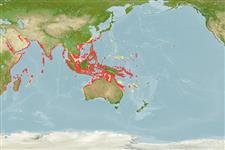Common names from other countries
>
Eupercaria/misc (Various families in series Eupercaria) >
Caesionidae (Fusiliers) > Caesioninae
Etymology: Caesio: Latin, caesius, bluish-grey, 1835; it is the same name given to the silvery metal (Cs) (Ref. 45335).
More on author: Cuvier.
Environment: milieu / climate zone / depth range / distribution range
Écologie
marin récifal; non migrateur; profondeur 0 - 50 m (Ref. 402). Tropical; 31°N - 28°S, 32°E - 167°E (Ref. 402)
Indo-West Pacific: Red Sea, Persian Gulf and East Africa to the Solomon Islands, north to southern Japan.
Taille / Poids / Âge
Maturity: Lm ? range ? - ? cm
Max length : 40.0 cm TL mâle / non sexé; (Ref. 402)
Épines dorsales (Total) : 10; Rayons mous dorsaux (Total) : 13 - 15; Épines anales: 3; Rayons mous anaux: 10 - 11. This species is distinguished by the following characters: a single postmaxillary process; D X, usually 14 soft rays; A III, usually 11soft rays; supratemporal band of scales generally interrupted at dorsal midline by a narrow scaleless zone; lateral line scales modally 49; scales above lateral line to dorsal -fin origin 7-10 (modally 8), below lateral line to anal-fin origin 14-19; predorsal scales 20-26; greatest body depth 2.2-3.1 in SL, head length 2.7-3.4 in SL; colour of body bluish, belly paler than upper sides; tips of caudal fin lobes, axil of pectoral fins, and upper base of pectoral fins black; caudal fin blue (except in juveniles where caudal fin and portions of caudal peduncle often yellow); pectoral, pelvic, and anal fins white to pale blue (pink or reddish after death); dorsal fin bluish (Ref. 68703, 90102).
Adults are found in coastal areas, mainly on or near coral reefs (Ref. 30573). They are more common along steep seaward reefs than in lagoons (Ref. 9710). They form large aggregations in midwater on upper edge of steep slopes and around patch reefs, often with other fusiliers (Ref. 90102). They feed on zooplankton. Are oviparous, with numerous, small pelagic eggs (Ref. 402).
Life cycle and mating behavior
Maturities | Reproduction | Spawnings | Egg(s) | Fecundities | Larves
Carpenter, K.E., 1987. Revision of the Indo-Pacific fish family Caesionidae (Lutjanoidea), with descriptions of five new species. Indo-Pac. Fish. (15):56 p. (Ref. 1723)
Statut dans la liste rouge de l'IUCN (Ref. 130435)
CITES (Ref. 128078)
Not Evaluated
Menace pour l'homme
Harmless
Utilisations par l'homme
Pêcheries: intérêt commercial mineur
Outils
Articles particuliers
Télécharger en XML
Sources Internet
Estimates based on models
Preferred temperature (Ref.
115969): 24.7 - 29.2, mean 28.2 (based on 1494 cells).
Phylogenetic diversity index (Ref.
82804): PD
50 = 0.5020 [Uniqueness, from 0.5 = low to 2.0 = high].
Bayesian length-weight: a=0.01660 (0.00866 - 0.03179), b=3.10 (2.93 - 3.27), in cm Total Length, based on LWR estimates for this species & (Sub)family-body (Ref.
93245).
Niveau trophique (Ref.
69278): 3.4 ±0.45 se; based on food items.
Résilience (Ref.
120179): Haut, temps minimum de doublement de population inférieur à 15 mois (Preliminary K or Fecundity.).
Fishing Vulnerability (Ref.
59153): Low to moderate vulnerability (30 of 100).
